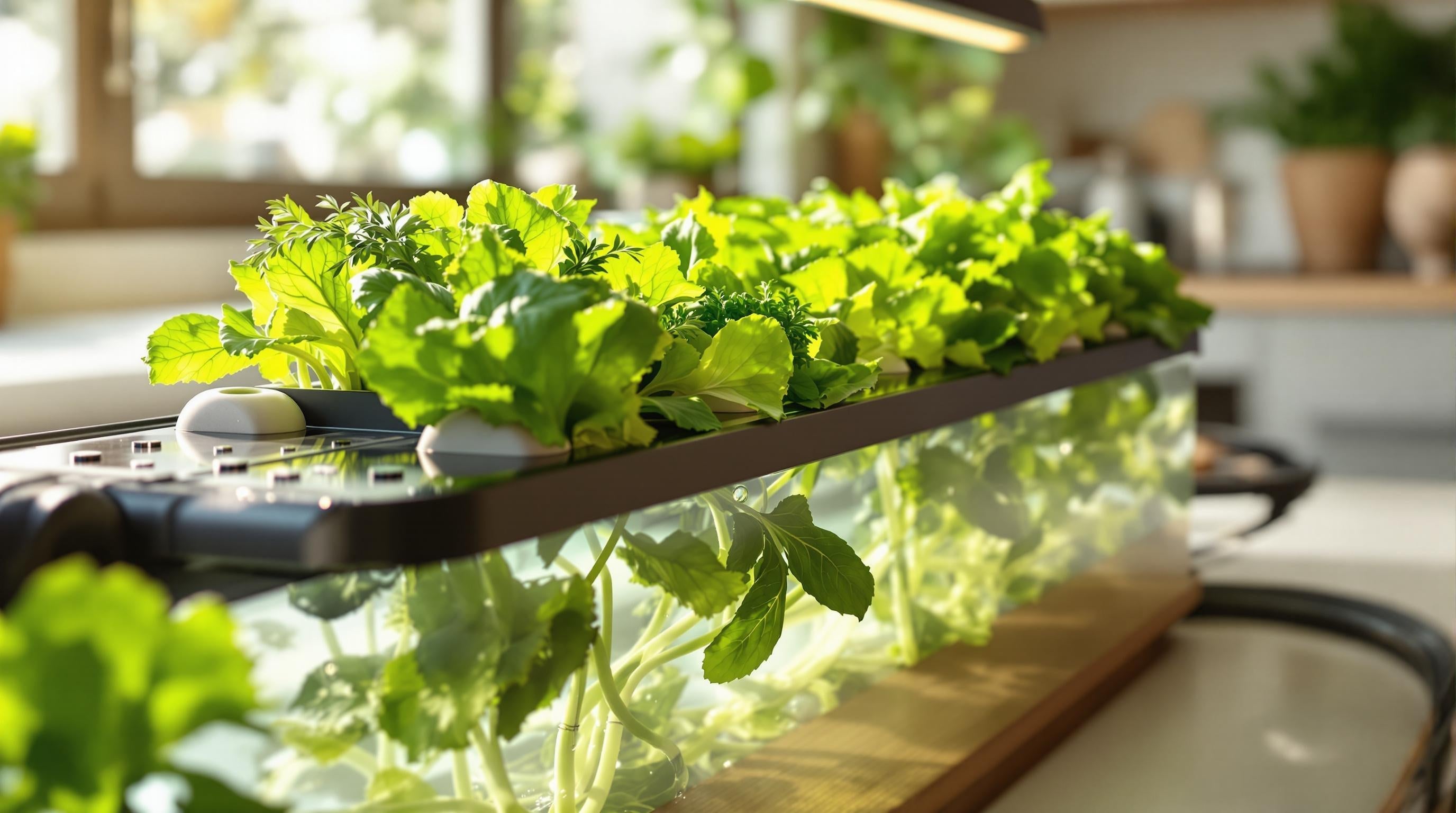Beginner’s Guide to DWC Hydroponics: Mastering Deep Water Culture Growing
Deep Water Culture (DWC) hydroponics is an easy, soil-free way to grow plants faster and with less water. Here's what you need to know:
- How It Works: Plant roots are submerged in oxygenated, nutrient-rich water, supported by net pots above the container.
-
Key Benefits:
- Faster growth (e.g., lettuce in 30 days vs. 60 in soil).
- Saves water with a recirculating system.
- Minimal daily maintenance.
- Compact setup for small spaces.
-
What You'll Need:
- A water container (e.g., buckets or reservoirs).
- Aeration system (air pump, stones, tubing).
- Net pots and growing media.
- Nutrient solution and pH control tools.
Quick Setup Steps:
- Fill your container with water and mix nutrients.
- Adjust pH to 5.5–6.5.
- Set up the air pump and stones for oxygenation.
- Place plants in net pots so roots touch the water.
- Keep water temperature a15–20°C and provide 18 hours of light daily.
Best Plants to Start With: Lettuce, herbs (basil, mint), and small vegetables like spinach.
DWC is perfect for beginners and works well indoors or outdoors. Start small, monitor pH and nutrients regularly, and enjoy faster harvests!
Deep Water Culture (DWC) Hydroponics System Tutorial
Required Equipment
To set up a DWC system, you'll need specific components to ensure healthy, soil-free plant growth. Here's what you'll need:
Water Container
The water container holds the nutrient solution and serves as the base of your DWC system.
| Container Type | Best For | Starting Price |
|---|---|---|
| Buckets & Lids | Small setups (1–2 plants) | $19.90 |
| Poly Tubs | Medium setups (3–4 plants) | $26.90 |
| Reservoirs | Dedicated systems | $41.90 |
| Water Tanks | Large-scale setups | $114.90 |
Use an opaque container to block light and reduce algae growth. Pick a size that matches your system's scale.
Next, you'll need to ensure proper oxygenation with an aeration system.
Aeration System
- Air Pump: Aqua One Air Pump ($20.90)
- Air Stones: Bioscape Mineral Slim Airstone 3-pack ($3.90) for smaller setups, or Disc Air Stone 80mm ($14.90) for larger systems
- Air Line Tubing: 4mm clear flexible tubing ($4.50)
These components help deliver oxygen to your plants' roots, which is essential for growth.
Plant Holders
Net pots are used to hold your plants and the growing media.
| Plant Type | Net Pot Size | Price |
|---|---|---|
| Herbs | 50 x 65mm | $0.60 |
| Lettuce | 45 x 50mm | $7.70/pack |
| Small Vegetables | 80 x 75mm | $1.10 |
| Large Vegetables | 140 x 100mm | $2.90 |
The 80 x 75mm "All Rounder" net pots are a favorite for beginners due to their durability and ability to be reused.
Setup Instructions
Water Preparation
Start by filling your water container with room temperature water, leaving enough space for the net pots.
- Mix 0.5 tsp (2.5 g) of nutrients per gallon (3.8 L) of water until fully dissolved.
- Use a calibrated pH meter to check the water's pH level.
- Adjust the pH with pH Up or Down solutions, adding drops slowly until the desired level is reached.
Tip: Place the container in its final location before filling it to avoid moving heavy, water-filled containers.
Air System Setup
Proper aeration keeps roots healthy. Set up your air system based on your container size:
| System Size | Air Flow Needed | Suggested Setup |
|---|---|---|
| Small (4-16L) | 1–4 L/min | Single air stone |
| Medium (20-40L) | 5–10 L/min | Two air stones |
| Large (40L+) | 10+ L/min | Multiple air stones or a disc diffuser |
- Position the air pump above the reservoir to prevent backflow.
- Add a non-return valve to the airline for extra safety.
- Connect air stones to ensure bubbles are evenly distributed.
Plant Support Assembly
- Place the net pots into the holes in the lid.
- Fill each pot with your chosen growing medium.
- Position plants so their roots touch the nutrient solution.
- Keep the water level about 1 inch (2.5 cm) above the bottom of the net pots.
Once assembled, test your system to confirm everything works as expected.
System Testing
Run your system for 24 hours to check the following:
- The air pump is functioning and bubbles are evenly distributed.
- Water temperature stays between 59–68°F (15–20°C).
- pH levels remain stable.
- No leaks are present.
Location Selection
After testing, choose the best location for your setup.
- For indoor systems, use LED or CFL lights.
- For outdoor systems, pick a spot with plenty of natural light.
- Keep the temperature between 75–80°F (24–27°C) and ensure the area is easily accessible for maintenance.
Important: Plants need 8 hours of darkness daily for healthy growth cycles. Keep the system away from direct heat sources to avoid overheating.
Best Plants for DWC
Growing Lettuce and Greens
Lettuce is a simple and popular choice for newcomers to DWC systems. Varieties like butterhead, romaine, and looseleaf are commonly grown. Typically, lettuce takes about 6–8 weeks to reach harvest, though under perfect conditions, it can mature faster. Aim to provide around 18 hours of light daily, paired with 6 hours of darkness, to support healthy growth.
Other easy-to-grow leafy greens include Swiss chard, kale, bok choy, and spinach.
Growing Herbs
Herbs thrive in DWC setups and are another great option for beginners. Some top picks include:
- Basil – grows quickly and produces high yields.
- Mint – grows vigorously and is well-suited for compact systems.
- Parsley – allows for ongoing harvests.
- Cilantro – another reliable choice for hydroponic systems.
Growing Vegetables
Once you've mastered greens and herbs, you can move on to lightweight vegetables that work well in DWC systems. Keep in mind the weight and space requirements of your plants, as DWC rafts are best suited for smaller, lighter crops. Here are a few tips for success:
- Keep an eye on calcium levels to prevent tip burn in leafy vegetables.
- Space plants according to their full-grown size to encourage proper growth.
- Ensure nutrient levels remain steady.
- Regularly check and adjust pH levels for optimal nutrient absorption.
If you're in a warmer climate, consider growing heat-tolerant vegetable varieties and provide shade during the hottest parts of the day. Avoid plants like rosemary that prefer dry conditions, as they don't perform well in water-heavy systems.
System Care and Problems
Water and Nutrient Care
Keep your DWC system’s water and nutrients in check to support healthy plant growth. Mature plants can use up to 2–3 gallons (7.6–11.4 liters) of nutrient solution daily during their peak growth stage. Check water levels daily and test electrical conductivity (EC) 2–3 times a week.
Water Management Tips:
- Replace the entire nutrient solution periodically.
- Top off with fresh water as needed to maintain levels.
Adjusting water use based on plant growth stages has been shown to cut water consumption by nearly 66%, saving about 9.9 gallons (37.5 liters) over six weeks.
In addition to managing nutrients, controlling pH is essential for proper nutrient absorption.
pH Balance and Root Health
Aim for a pH range of 5.5–6.2 to keep plants thriving. Test pH levels along with EC measurements to maintain the right growing conditions.
"The pH measurement lets the grower know about the acidic or basic nature of the solution, which can affect nutrient uptake by the plants." – Chris Mullins, Extension Specialist, Virginia State University
pH Management Tips:
- Test pH levels 2–3 times weekly.
- Adjust fertilizer concentration based on EC readings.
- Use reverse osmosis (RO) water if your tap water’s EC exceeds 0.8 mS/cm.
Proper pH management also helps prevent algae, which can disrupt your system.
Algae Prevention
Algae can interfere with your DWC system’s performance. Here’s how to keep it under control:
Light Control:
- Use opaque or dark-colored containers.
- Cover reservoirs with solid lids or black plastic.
- Wrap transparent components with dark tape or coverings.
System Maintenance:
- Keep water moving using air stones or pumps.
- Clean system components regularly with diluted hydrogen peroxide.
- Maintain a slightly acidic pH (5.5–6.5).
- Ensure proper airflow and water circulation.
Different algae types may require specific treatments. Green algae is common and easier to manage, while blue-green algae (cyanobacteria) can release harmful toxins and may need more aggressive measures.
Eco-Friendly DWC Tips
Here are some ways to make your DWC system more sustainable while keeping it efficient.
Water Sources
Rainwater harvesting is a practical way to supply your hydroponic system while cutting costs. Many homeowners in Australia already use this approach.
Here’s how to set up a rainwater collection system:
- Install gutters and downspouts to channel roof runoff
- Use food-grade storage containers
- Add basic filtration to remove debris
- Test the water quality before using it
"Despite sounding complex, rainwater harvesting is much simpler than most people imagine." – Enviro Friendly
If you're growing edible plants, consider a potable rainwater system with extra filtration and treatment steps to ensure it’s safe for consumption.
Local Supply Options
Green Genius offers DWC equipment designed specifically for Australian conditions. Their products include:
- Food-grade reservoirs and containers
- Energy-efficient air pumps
- UV-resistant net pots
- Locally made growing media
Using high-quality, locally sourced materials ensures your system performs well and lasts longer, even in challenging climates.
Power Saving Methods
Cut down on energy use while keeping your plants thriving:
- Switch to LED grow lights to reduce heat and maintain stable water temperatures
- For smaller setups, try the Kratky method to avoid using energy-intensive pumps
- Keep water temperature steady and ensure your air pump runs continuously for proper oxygen delivery
Keeping water temperatures in check is essential. Warm water holds less oxygen, which can harm plant health. These tips can make your DWC system more efficient and cost-effective.
Wrap-Up
Main Points
DWC hydroponics provides an efficient way to grow plants without using soil. To ensure healthy plant growth, keep the water temperature between 60–68°F (15–20°C) and maintain a pH level of 5.5 to 6.5. An air pump and airstone are crucial for delivering oxygen to the roots by running continuously.
"Plants grown in DWC setups have easier access to oxygen and nutrients, which means they spend less energy searching for nutrients and developing roots. As a result, plants will reward you with fast vegetative growth and excellent yields." – Royal Queen Seeds
With these basics covered, you're ready to dive into your DWC journey.
Getting Started
Green Genius starter kits make setting up a DWC system easier by including reliable pH testers and food-safe reservoirs.
Here are the key things to focus on:
- Temperature Control: Keep the root zone temperature steady at 60–68°F (15–20°C) for healthy plants.
- Regular Maintenance: Replace the nutrient solution every week to avoid imbalances.
- Proper Setup: Ensure the roots are partially exposed, with about 1.5 inches (38 mm) above the water level.
If you're new to DWC, start small. Try growing easy plants like lettuce or herbs to gain confidence before expanding your system.
Related posts
- Soil vs Hydroponics: Comparing Growth Rates and Yields
- Comparing the different types of indoor growing
- A Comprehensive Guide to Sustainable Gardening and Agriculture
- How Biodegradable Nutrient Carriers Work in Hydroponics

